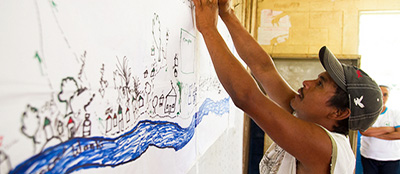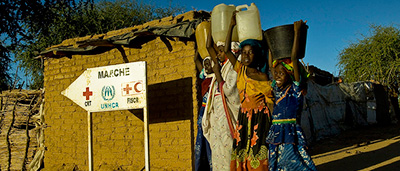The aim of humanitarian action is to support people affected by conflict and natural disasters – to save lives, alleviate suffering and maintain human dignity during crisis. Humanitarian action can take many forms and has been conceived in many different ways over time. As enshrined in United Nations (UN) Resolution 46/182 (1991), it is associated…» more
Humanitarian Issues
Conflict sensitivity
Reflection among aid actors after the devastating genocide in Rwanda led to the realisation that humanitarian and development actors contributed to increasing tensions and exacerbating the conflict. Aid interventions have since been understood to become a part of the context – and in conflict settings, to become part of the conflict. This acknowledgement that aid is not neutral ...» more
Refugee, IDP and host community radicalisation
Socioeconomic conditions: In some circumstances, poor socioeconomic conditions (e.g. impoverishment, unemployment, lack of access to services and infrastructure, overcrowded living conditions) may make it more likely for refugees/IDPs to become radicalised. However, Lischer (2005) finds instead that there is generally little evidence to support the connection between particular ...» more
Social protection, climate change adaptation and disaster risk reduction
This rapid literature review presents and synthesises the conceptual underpinnings and evidence on the relationship between social protection, climate change adaptation and disaster risk reduction. Social protection instruments have been shown to be effective mechanisms for coping with shocks. The recent growth of social protection systems has shown that having systems in ...» more
Faith-based organisations, conflict resolution and anti-corruption
This rapid report reviews the literature on faith-based development organisations (FBOs) and their role in conflict resolution and anti-corruption. In both areas the literature suggests that religious actors could play a decisive role, but that this has not been realised. The evidence on FBOs and conflict resolution is moderately robust. Nearly all literature provides case ...» more
Non-food items (NFIs) and the needs of women and girls in emergencies
The NFIs which best meet the basic needs of women and girls in emergencies include: Hygiene/dignity kits: women and adolescent girls require locally appropriate sanitary items to manage their menstrual hygiene. These may be reusable cloth or disposable sanitary pads. The opportunities for privately washing, drying, and disposing of sanitary cloths or reusable pads need to be ...» more
Funding appeals for complex humanitarian emergencies
Key findings: It is possible to derive some key factors from the available literature: Needs-based allocation: This is a core principle of humanitarian assistance. All funders use needs assessments in their original funding allocations, and many changes to funding are preceded by needs assessments. Tipping points: Most protracted crises receive a steady and/or low level of ...» more
Key actors, dynamics and issues of Libyan political economy
The scene of actors in Libya is highly fragmented, localised and fluid. The main division seems to have been between forces that support continued changes (‘pro-revolution’) and others that do not (‘anti-revolution’). Community actors: - Geographic communities. Beyond differences between Cyrenaica, Tripolitana and Fezzan, local communities have been the fundamental actors. ...» more
Urban humanitarian crises
The degree to which a city is vulnerable to humanitarian crises depends on location-specific physical, social, economic and environmental factors. The literature suggests that geographically, cities in Asia are the most vulnerable to natural disasters. Asian cities also experience the most diverse range of natural disasters. The main causes of urban vulnerability are often ...» more
Evidence of impact of emergency cash transfers on gender and protection
Key messages: The major trends and gaps in the evidence in this report are: On the whole, ‘gender’ is used to refer to women. More recent papers include more analysis of how CTs impact men, especially on if they find it disempowering for women to be favoured as beneficiaries. Gender analysis is not deeply ingrained into emergency CT programme evaluation. Many papers include a ...» more
Disaster resilience
The impacts of disasters on development, poverty and vulnerability have led to calls for improving disaster resilience – the capacity to cope with and adapt to shocks and stresses associated with natural hazards. What do we know about what can enable or constrain disaster resilience? This Topic Guide for policymakers and practitioners synthesises the evidence, approaches and ...» more
Political economy of Libya after the Qadhafi regime
Libya lacks a stable, unified and inclusive state. Qadhafi wielded oil-funded patronage and repression to weaken the state and any social counterweight to his power. The predominant social and political dynamic is fragmentation based on multiple interests, identities and loyalties. The major ones are cities, regions, tribes (including factions and families), political ...» more
Restrictions on humanitarian aid to refugees
The evidence base for this question is extremely weak. Very little of the literature uncovered during this rapid review engages directly or in depth with the question of the impact of such aid restrictions. Even fewer analyse how the humanitarian community has responded to these restrictions. A related debate is ongoing around aid provisions to urban refugees and the ...» more
Assessing seismic risk in Ethiopia
There is limited literature available in this area. Abeye (2012) argues that an updated seismic hazard map of Africa is long overdue. In a case study analysis of the Ethiopian capital Addis Ababa, a 1999 UNIDSR report identified as challenges an absence of previous seismic risk assessment, few specialists and limited practice in seismology and earthquake engineering, low ...» more
The shadow economy in conflict-affected countries
Approaches which can be used to leverage the positive social function that shadow economies provide to conflict-affected populations include: Using humanitarian aid to complement people’s coping strategies (Goodhand, 2006). Understanding the relationship between different aspects of the economy through stakeholder assessments can reduce the risk that interventions have ...» more
Measuring disaster resilience
Several agencies have developed guidance for measuring disaster resilience. One of the most comprehensive and widely-cited frameworks is Twigg’s (2009) ‘characteristics of resilience’ framework. Based on five dimensions of resilience identified in the Hyogo Framework for Action (governance, risk assessment, knowledge and education, risk management and vulnerability reduction, ...» more
Community-based disaster risk management in Pakistan
Disaster risk management (DRM), including disaster risk reduction (DRR), has received increased attention - particularly community-based DRM (CBDRM). Despite limited implementation and very limited evidence, some findings emerge: Factors of success have included: - Work that is multi-sectoral, integrated and multi-hazard. - Good programming, with high-quality analysis, ...» more
Democratic Republic of the Congo internally displaced persons and refugees’ relations with host communities
This is a relatively unexplored area with the literature limited mainly to NGO reports. However a few studies have looked at the questions and find that the reasons IDPs/refugees choose to stay with host communities are a combination of factors relating to their physical, emotional and spiritual security, including: They have a negative perception of the conditions in camps and ...» more
Impact of extensive disasters
Extensive risk is defined by UNISDR as ‘The widespread risk associated with the exposure of dispersed populations to repeated or persistent hazard conditions of low or moderate intensity, often of a highly localized nature, which can lead to debilitating cumulative disaster impacts’. Examples of types of extensive disasters are given in the literature as floods, landslides, ...» more
Disaster risk governance at national and sub-national levels
Though the term disaster risk governance is rarely used, there is a large body of literature that relates to the governance of disaster risk in low- and middle-income countries with a focus on national or sub-national levels. This brief helpdesk research report identifies some of the most notable literature in this area and attempts to identify common conclusions. ‘Disaster ...» more


